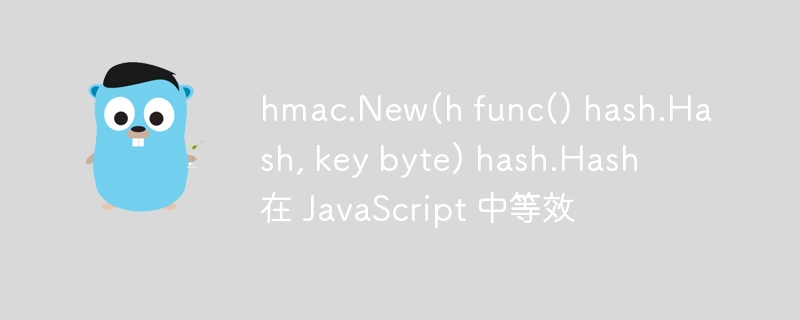hmac.New(h func() hash.Hash, key byte) hash.Hash 在 JavaScript 中等效

在PHP中,我們經常需要使用加密演算法來保護資料的安全性。 HMAC(Hash-based Message Authentication Code)是一種常用的加密演算法,用於驗證資料完整性和身份認證。在PHP中,我們可以使用hmac.New()函數來建立HMAC實例,該函數需要指定一個雜湊函數和一個金鑰。與此類似,在JavaScript中,我們可以使用等效的方法來實現相同的功能。在本文中,我將為您介紹如何在JavaScript中使用等效的方法來建立HMAC實例,以及如何在PHP和JavaScript之間進行資料的加密和解密。
問題內容
差點在go lang hmac.new的js實作中卡住好幾天了。然而,沒有成功。我使用 crypto、crypto-js 和 stablelib 模組進行實作。問題是,在go lang版本中,hmac實例可以透過hmac實例建立。例如(程式碼區塊正確且經過測試):
hmacf := hmac.New(func() hash.Hash {
return hmac.New(func() hash.Hash {
return hmac.New(func() hash.Hash {
return hmac.New(sha256.New, []byte(SALT))
}, []byte(path[0]))
}, []byte(path[1]))
}, []byte(path[2]))其實我也不知道它是怎麼運作的!因為在所有與 javascript 相關的模組中,您無法從 hmac 建立 hmac,並且它們接受確定雜湊演算法的 string 值。
也許最好問如何在javascript中從hmac建立hmac。
解決方案是什麼?
當 go 版本的輸出與您的實作的輸出相同時;您的解決方案是正確的。
解決方法
根據規格 (rfc 2104),hmac 使用摘要函數內部,例如sha256。
但是,您的實作應用了(實際上不相容)內部使用另一個 hmac 而不是摘要的 hmac,其中只有最低等級的 hmac 在內部使用常規摘要。這樣就創建了一個嵌套結構。
基於常規 hmac(帶有摘要)的規範,這可以擴展到 go 程式碼中使用的帶有 hmac(而不是摘要)的 hmac:
hmac(k xor opad, hmac(k xor ipad, text)) s。 rfc2104,第 2 節。 hmac 的定義
由於與規範的差異,找到一個開箱即用的支援此類功能的 javascript 庫可能不會那麼容易。
雖然大多數函式庫當然支援hmac,但只允許指定摘要(而不是hmac),例如nodejs的crypto模組的crypto.createhmac(),請參見還有其他答案。我認為這種方法不能用於實作 go 程式碼中的邏輯。
如果其他答案的方法不起作用,並且您找不到另一個具有所需功能的 javascript 庫,您可以自己在 javascript 中實現邏輯,因為 hmac 的規範相對簡單(見上文) )。
以下程式碼是 nodejs 的 crypto 模組的範例實作:
var crypto = require('crypto')
const digest = 'sha256'
const blocksize = 64 // block size of the digest
// define input parameter
var salt = buffer.from('salt')
var path = [ buffer.from('alfa'), buffer.from('beta'), buffer.from('gamma') ]
var data = buffer.from('data')
// calculate hmac
var hmac = hmac(data, salt, path)
console.log(hmac.tostring('hex'))
function hmac(data, salt, path) {
// create keylist
var keylist = []
keylist.push(salt)
keylist = keylist.concat(path)
// determine hmac recursively
var result = hmac_rec(data, keylist)
return result
}
function hmac_rec(data, keylist) {
// adjust key (according to hmac specification)
var key = keylist.pop()
if (key.length > blocksize) {
k = buffer.allocunsafe(blocksize).fill('\x00');
if (keylist.length > 0) {
hmac_rec(key, [...keylist]).copy(k)
} else {
gethash(key).copy(k)
}
} else if (key.length < blocksize) {
k = buffer.allocunsafe(blocksize).fill('\x00');
key.copy(k)
} else {
k = key
}
// create 'key xor ipad' and 'key xor opad' (according to hmac specification)
var ik = buffer.allocunsafe(blocksize)
var ok = buffer.allocunsafe(blocksize)
k.copy(ik)
k.copy(ok)
for (var i = 0; i < ik.length; i++) {
ik[i] = 0x36 ^ ik[i]
ok[i] = 0x5c ^ ok[i]
}
// calculate hmac
if (keylist.length > 0) {
var innerhmac = hmac_rec(buffer.concat([ ik, data ]), [...keylist])
var outerhmac = hmac_rec(buffer.concat([ ok, innerhmac ]), [...keylist])
} else {
var innerhmac = gethash(buffer.concat([ik, data]))
var outerhmac = gethash(buffer.concat([ok, innerhmac]))
}
return outerhmac
}
// calculate sha256 hash
function gethash(data){
var hash = crypto.createhash(digest);
hash.update(data)
return hash.digest()
}
結果:
2e631dcb4289f8256861a833ed985fa945cd714ebe7c3bd4ed4b4072b107b073
測試:
以下 go 程式碼產生相同的結果:
package main
import (
"crypto/hmac"
"crypto/sha256"
"encoding/hex"
"fmt"
"hash"
)
func main() {
salt := "salt"
path := []string{"alfa", "beta", "gamma"}
hmacf := hmac.new(func() hash.hash {
return hmac.new(func() hash.hash {
return hmac.new(func() hash.hash {
return hmac.new(sha256.new, []byte(salt))
}, []byte(path[0]))
}, []byte(path[1]))
}, []byte(path[2]))
hmacf.write([]byte("data"))
result := hmacf.sum(nil)
fmt.println(hex.encodetostring(result)) // 2e631dcb4289f8256861a833ed985fa945cd714ebe7c3bd4ed4b4072b107b073
}
編輯:
受這篇文章的啟發,以下是hmac_rec() 的更緊湊/高效的實現,它使用常規最後一個迭代步驟的hmac(這也使得gethash() 過時):
function hmac_rec(data, keyList) {
var key = keyList.pop()
if (keyList.length > 0) {
// adjust key (according to HMAC specification)
if (key.length > blockSize) {
k = Buffer.allocUnsafe(blockSize).fill('\x00');
hmac_rec(key, [...keyList]).copy(k)
} else if (key.length < blockSize) {
k = Buffer.allocUnsafe(blockSize).fill('\x00');
key.copy(k)
} else {
k = key
}
// create 'key xor ipad' and 'key xor opad' (according to HMAC specification)
var ik = Buffer.allocUnsafe(blockSize)
var ok = Buffer.allocUnsafe(blockSize)
k.copy(ik)
k.copy(ok)
for (var i = 0; i < ik.length; i++) {
ik[i] = 0x36 ^ ik[i]
ok[i] = 0x5c ^ ok[i]
}
// calculate HMAC
var innerHMac = hmac_rec(Buffer.concat([ ik, data ]), [...keyList])
var outerHMac = hmac_rec(Buffer.concat([ ok, innerHMac ]), [...keyList])
} else {
var outerHMac = crypto.createHmac(digest, key).update(data).digest();
}
return outerHMac
}
以上是hmac.New(h func() hash.Hash, key byte) hash.Hash 在 JavaScript 中等效的詳細內容。更多資訊請關注PHP中文網其他相關文章!

熱AI工具

Undresser.AI Undress
人工智慧驅動的應用程序,用於創建逼真的裸體照片

AI Clothes Remover
用於從照片中去除衣服的線上人工智慧工具。

Undress AI Tool
免費脫衣圖片

Clothoff.io
AI脫衣器

AI Hentai Generator
免費產生 AI 無盡。

熱門文章

熱工具

記事本++7.3.1
好用且免費的程式碼編輯器

SublimeText3漢化版
中文版,非常好用

禪工作室 13.0.1
強大的PHP整合開發環境

Dreamweaver CS6
視覺化網頁開發工具

SublimeText3 Mac版
神級程式碼編輯軟體(SublimeText3)

熱門話題
 比特幣誕生至今價格2009-2025 最完整的BTC歷史價格總表
Jan 15, 2025 pm 08:11 PM
比特幣誕生至今價格2009-2025 最完整的BTC歷史價格總表
Jan 15, 2025 pm 08:11 PM
自 2009 年問世以來,比特幣成為加密貨幣界的領頭羊,其價格經歷了巨大的波動。為了提供全面的歷史概述,本文匯集了從 2009 年到 2025 年的比特幣價格數據,涵蓋了重大的市場事件、市場情緒變化和影響價格走勢的重要因素。
 比特幣誕生至今歷史價格總覽 比特幣歷史價格趨勢大全
Jan 15, 2025 pm 08:14 PM
比特幣誕生至今歷史價格總覽 比特幣歷史價格趨勢大全
Jan 15, 2025 pm 08:14 PM
比特币,作为一种加密货币,自问世以来经历了显著的市场波动。本文将提供比特币自诞生以来的历史价格总览,帮助读者了解其价格趋势和关键时刻。通过分析比特币的历史价格数据,我们可以了解市场对其价值评估、影响其波动的因素,并为未来投资决策提供依据。
 比特幣誕生至今歷史價格一覽 BTC歷史價格行情趨勢圖(最新匯總)
Feb 11, 2025 pm 11:36 PM
比特幣誕生至今歷史價格一覽 BTC歷史價格行情趨勢圖(最新匯總)
Feb 11, 2025 pm 11:36 PM
比特幣自 2009 年創世以來,價格經歷多次大幅波動,最高漲至 2021 年 11 月的 69,044.77 美元,最低跌至 2018 年 12 月的 3,191.22 美元。截至 2024 年 12 月,最新價格突破 100,204 美元。
 2018-2024年比特幣最新價格美元大全
Feb 15, 2025 pm 07:12 PM
2018-2024年比特幣最新價格美元大全
Feb 15, 2025 pm 07:12 PM
實時比特幣美元價格 影響比特幣價格的因素 預測比特幣未來價格的指標 以下是 2018-2024 年比特幣價格的一些關鍵信息:
 如何通過CSS自定義resize符號並使其與背景色統一?
Apr 05, 2025 pm 02:30 PM
如何通過CSS自定義resize符號並使其與背景色統一?
Apr 05, 2025 pm 02:30 PM
CSS自定義resize符號的方法與背景色統一在日常開發中,我們經常會遇到需要自定義用戶界面細節的情況,比如調...
 H5頁面製作是前端開發嗎
Apr 05, 2025 pm 11:42 PM
H5頁面製作是前端開發嗎
Apr 05, 2025 pm 11:42 PM
是的,H5頁面製作是前端開發的重要實現方式,涉及HTML、CSS和JavaScript等核心技術。開發者通過巧妙結合這些技術,例如使用<canvas>標籤繪製圖形或使用JavaScript控制交互行為,構建出動態且功能強大的H5頁面。
 為什麼inline-block元素會出現錯位現象?如何解決這個問題?
Apr 04, 2025 pm 10:39 PM
為什麼inline-block元素會出現錯位現象?如何解決這個問題?
Apr 04, 2025 pm 10:39 PM
關於inline-block元素錯位顯示的原因及解決方案在編寫網頁佈局時,我們常常會遇到一些看似奇怪的顯示問題。比...







